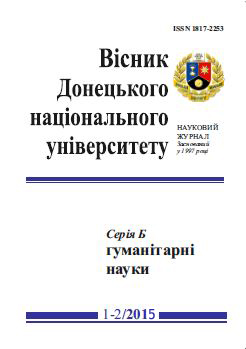The concept of «runestone» in present runology studies.
Keywords:
runestone, memorial literacy, historical memory, runologist, scientific researchesAbstract
In the article research interest is considered in definition of concept-category terminology of runology research. The concept of «runestone» is received varying interpretations in works of scholars of several branches of human knowledge. Researchers understand it from an individual visual display of the aims of the commissioner to the unique «means of mass media» which is fixed historical memory. The main attention concentrates on consideration and the analysis of contexts of «runestone» in works of European researchers. It is defined that historians and archeologists understand runology monuments as the bright «associative tool» of fixing of social memory and runologist emphasize an authentic «oral tradition» of stones. The definition of the «runestone» is given as the result of research.References
Chruszczewski P. P. Runic inscriptions as instances of proto-books / P. P. Chruszczewski // Studia linguistic Universitatis Iagellonicae Cracoviensis. – Vol. 126. – Krakow, 2009. – P. 25-31.
Danielsson Ing-Marie Back Walking down memory lane: rune-stones as mnemonic agents in the landscapes of late Viking-age Scandinavia / Ing-Marie Back Danielsson // Early Medieval stone monuments: materiality,biography, landscape. – Edited by Howard Williams, Joanne Kirton and Meggen Gondek. – UK: The Boydell Press, 2015. – P. 62-86.
Jesch J. Memorials in speech and writing / J. Jesch // Hikuin. – Vol. 32. – 2005. – P. 95-104.
Marjolein Stern Changing monuments: the adapting and adopting of runestones and the effects on their perception and decipherment / Marjolein Stern // Reading Runes: The 8th international symposium on runes and runic inscriptions, nyköping. – Sweden, September 1-6, 2014. – P. 54-56.
Moesgaard O. N. Runestones as Communication – the Danish material / Oeby Nielsen Gunhild Moesgaard // Offa Berichte und Mitteilungen zur Urgeschichte, Fruhgeschichte und Mittelalterarchaologie. – Band 58. – 2001. – P. 165-172.
Sawyer B. The Viking-age rune-stones custom and commemoration in Early Medieval Scandinavia / Birgit Sawyer. – Oxford: University press, 2000. – 269 p.
Schutle Michael Runology and historical sociolinguistics: on runic writing and its social history in the first millennium / Michael Schutle // Journal of Historical Sociolinguistics. – vol.1. – 2015. – P. 87-110.
Van Dyke R. M. Imagined pasts imagined. Memory and ideology in archaeology / Van Dyke R. M. // R. Bernbeck and R. H. McGuire (eds), Ideologies in Archaeology. – Tuscon: University of Arizona Press, 2011. – P. 233-253.
Van Dyke R. M. Susan E. Alcock Archaeologies of Memory / Van Dyke R. M. Susan E. Alcock. – UK.: Blackwell Publishers Ltd a Blackwell Publishing company, 2003. – 230 p.
Williams H. Read What’s There: Interpreting Runestone Inscriptions / H. Williams // Futhark: International Journal of Runic Studies. – Vol.1. – 2010. – P. 27-40.
Zilmer K. On the symbiosis of orality and literacy in some Christian runestone in scriptions / K. Zilmer // The 14th International Saga Conference Uppsala, 9th -15th August 2009. – Volume 2. – 2009. – Gavle: Gavle University Press. – P. 1074-1081.
Zilmer K. Sight words in medieval runic inscriptions – a strategy of runic literacy/ Kristel Zilmer //Reading Runes: The 8th international symposium on runes and runic inscriptions, nyköping. – Sweden, September 1-6, 2014. – P. 69-70.

